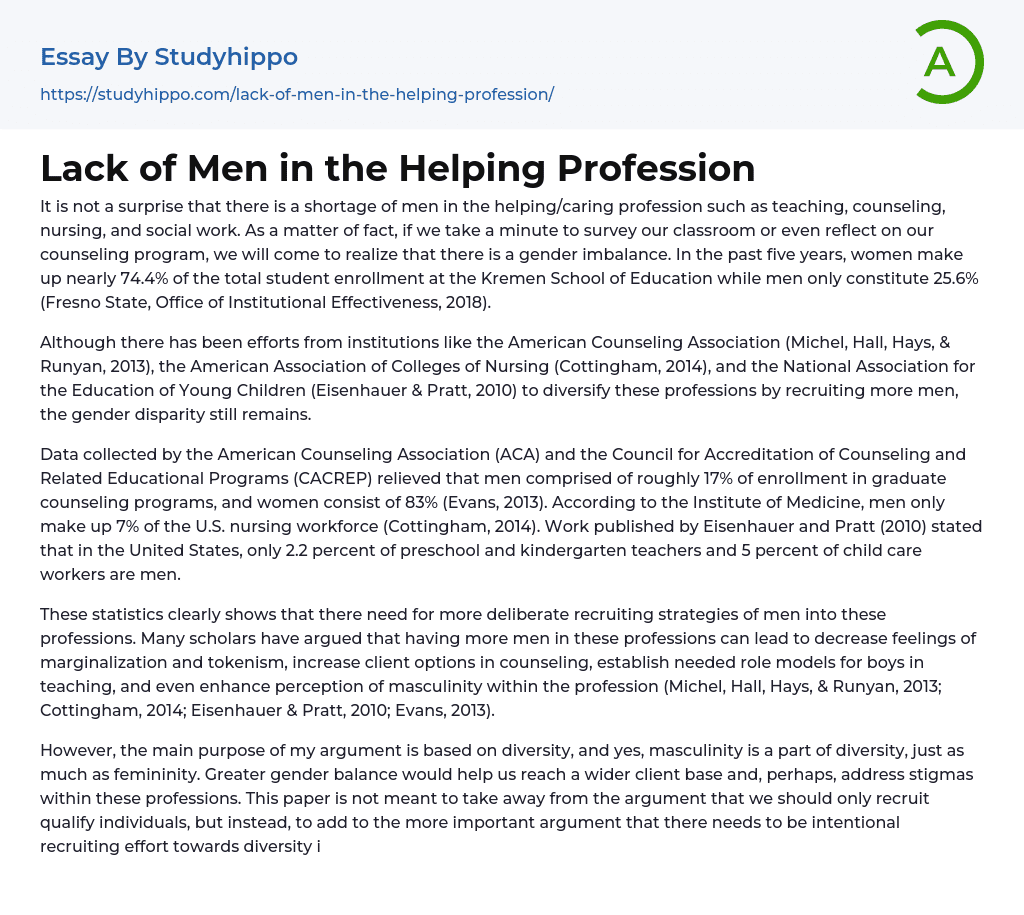Helping/caring professions such as teaching, counseling, nursing, and social work are experiencing a shortage of men. This gender imbalance is evident in both the classroom and counseling program. According to data provided by the Fresno State Office of Institutional Effectiveness (2018), women have made up 74.4% of total student enrollment at the Kremen School of Education over the past five years, while men account for only 25.6%. Despite efforts from various institutions like the American Counseling Association (Michel, Hall, Hays, & Runyan, 2013), the American Association of Colleges of Nursing (Cottingham, 2014), and the National Association for the Education of Young Children (Eisenhauer & Pratt, 2010) to recruit more men and promote diversity in these professions, there continues to be an ongoing gender disparity.
Based on data from the American Counseling Association (ACA) and the Council for Accreditat
...ion of Counseling and Related Educational Programs (CACREP), approximately 17% of men are enrolled in graduate counseling programs, while women constitute around 83% (Evans, 2013). The Institute of Medicine's report indicates that men make up only 7% of the nursing workforce in the United States (Cottingham, 2014). A study conducted by Eisenhauer and Pratt in 2010 discovered that male representation is as low as 2.2 percent among preschool and kindergarten teachers, as well as just 5 percent among child care workers nationwide.
The statistics show that there is a clear need for more intentional recruitment strategies to attract men to these professions. Scholars have emphasized the importance of increasing male representation in these fields as it can reduce feelings of marginalization and tokenism, broaden counseling options for clients, provide male role models in education, and improve perceptions of masculinity within
the profession (Michel, Hall, Hays, ; Runyan, 2013; Cottingham, 2014; Eisenhauer ; Pratt, 2010; Evans, 2013). However, my main argument revolves around achieving diversity which includes both masculinity and femininity. By achieving a better gender balance we can reach a wider client base and potentially address existing stigmas within these professions.
The purpose of this paper is not to diminish the argument for recruiting only qualified individuals, but rather to emphasize the more important argument for intentionally recruiting a diverse workforce in the helping profession. Two of the three studies I found strongly advocated mentorship. In the study titled "Attracting, Recruiting and Retaining Male Teachers: Policy Issues in the Male Teacher Debate," the authors recommend that male teachers promote the teaching profession at school and university career fairs. They also propose the establishment of a program in secondary schools where current male teachers can mentor male students aspiring to become teachers (Mills et al., 2004).
Participants in the study “A Mixed Methods Study of Male Recruitment in the Counseling Profession” suggested implementing program initiatives such as support groups, mentoring programs, and faculty commitment to diversity to establish a welcoming environment for men in a graduate counseling program (Michel et al., 2013, pp. 480). Based on these recommendations, I plan to develop a six-week mentorship program that pairs male high school students with male professionals in helping professions. I have chosen this particular age group because, according to Gottfredson’s circumscription and compromise theory, individuals at this stage begin to solidify their mental list of acceptable occupations. In Gottfredson's theory, he also suggests that occupational choices are influenced by factors such as gender stereotypes, societal prestige, and personal interests
(Gottfredson, 2005).
The aim of this mentoring program is to provide male high school students with the chance to observe successful men in helping professions. By doing so, they can gain knowledge about these occupations and gather practical information. The program lasts for six weeks and aims to help students broaden or narrow their career choices by forming connections with these professions. Its primary objective is to establish a social support system for male students interested in jobs that are typically dominated by women.
The mentorship program requires a weekly face-to-face meeting lasting at least one hour for both the mentor and mentee. They should establish three specific goals during this six-week period. The mentee must observe the mentor's activities twice throughout the program. Both parties should communicate their progress each week through email, text messages, or phone calls. It is suggested that the mentor invites the mentee to participate in a professional event like a conference if possible.




